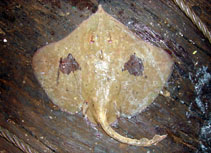| Family: |
Rajidae (Skates) |
| Max. size: |
130 cm TL (male/unsexed) |
| Environment: |
demersal; marine; depth range 50 - 457 m |
| Distribution: |
Southeast Atlantic: known only from Lüderitz, Namibia to Port Alfred, Eastern Cape (South Africa) |
| Diagnosis: |
A striking two-toned longnose skate, medium brown above and abruptly dark grey below, with a large, conspicuous, dark brown blotch on the upper base of each pectoral fin (Ref. 5578). Snout moderately elongated and bluntly triangular, and tail stout, not conspicuously swollen and about equal to body length; pectoral disc with broadly rounded corners and smooth underside without denticles; thorns at nape and along midline of back and tail to 1st dorsal fin, nape spine enormous in young (Ref. 5578). Hatchlings and juveniles with wide-spaced black spots on upper disc, inconspicuous or lost in adolescents and adults; adults sometimes with numerous small white spots (Ref. 5578). Underside with numerous black pores (Ref. 5578). |
| Biology: |
Found on soft bottoms of the outer shelf and upper slope (Ref. 5578). Feeds on bony fish, crabs, shrimp, mysids, mantis shrimp, euphausiids, bivalves and cuttlefish (Ref. 5578). Oviparous (Ref. 50449). Eggs have horn-like projections on the shell (Ref. 205). Males reaches maturity at 88-96 cm TL, females possibly slightly larger off Western than Southern coast of South Africa; hatching size at ca. 19 cm TL (Ref. 114953). Commonly taken by hake trawlers (Ref. 5578). Extremely slippery when caught (Ref. 5578). |
| IUCN Red List Status: |
Least Concern (LC); Date assessed: 01 August 2019 Ref. (130435)
|
| Threat to humans: |
harmless |
Source and more info: www.fishbase.org. For personal, classroom, and other internal use only. Not for publication.

